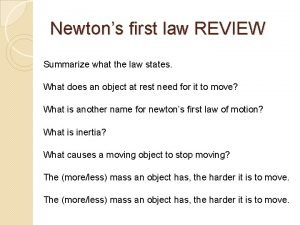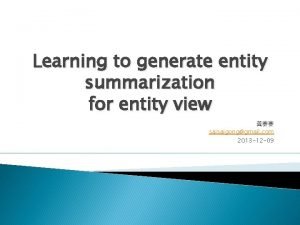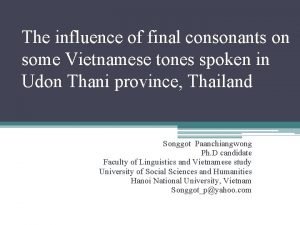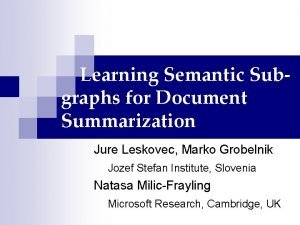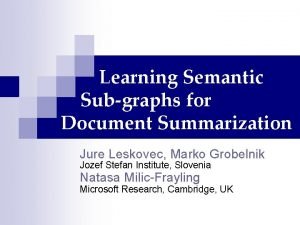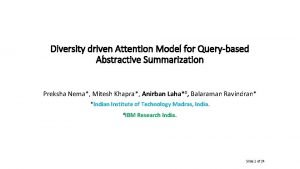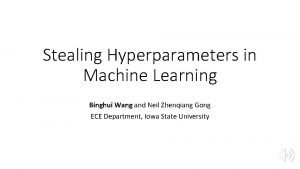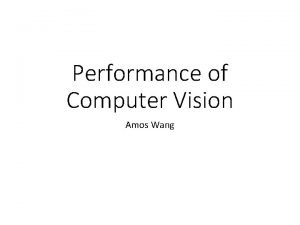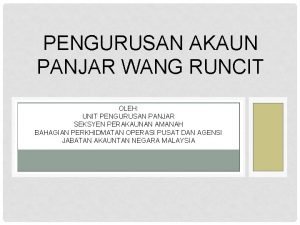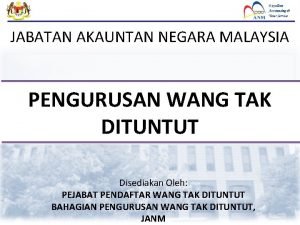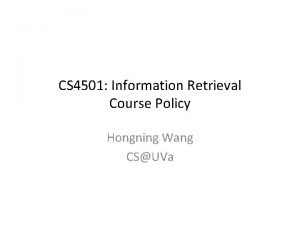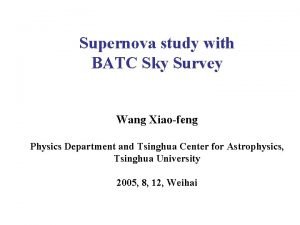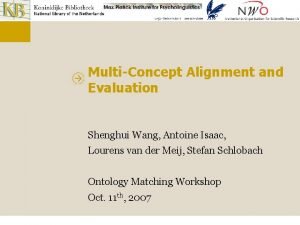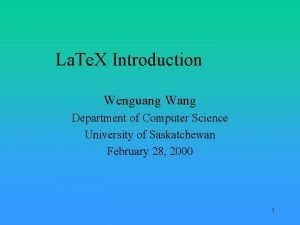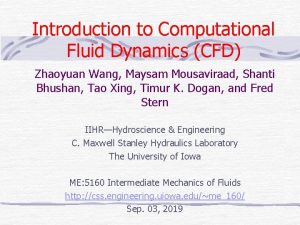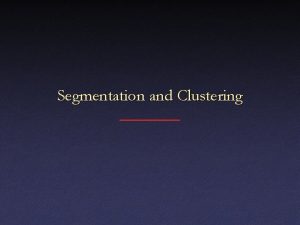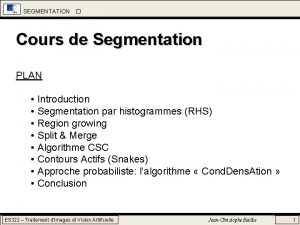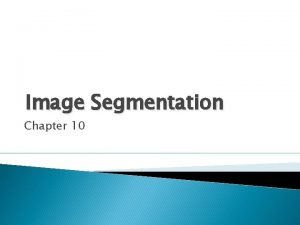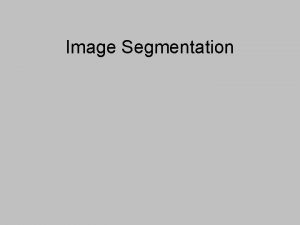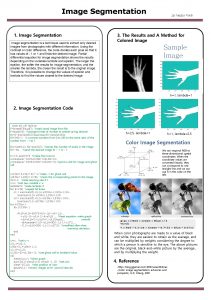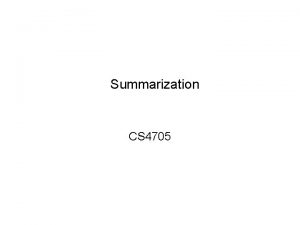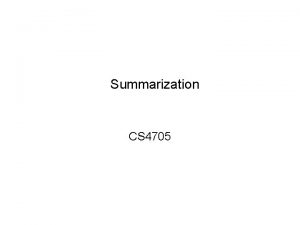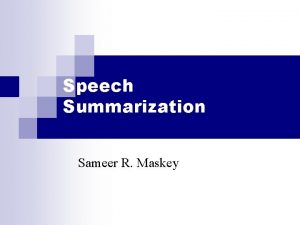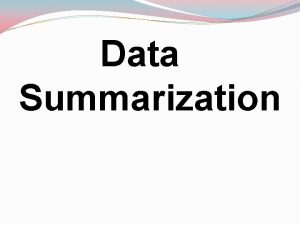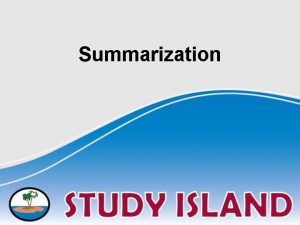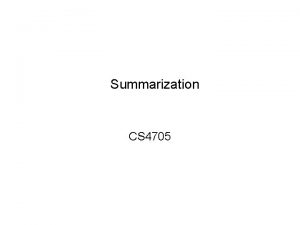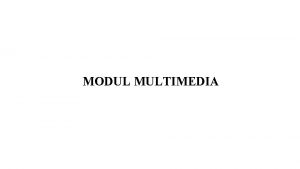Multimedia Segmentation and Summarization Dr JiaChing Wang Honorary












































- Slides: 44

Multimedia Segmentation and Summarization Dr. Jia-Ching Wang Honorary Fellow, ECE Department, UW-Madison

Outline n Introduction n Speaker Segmentation n Video Summarization n Conclusion Multimedia Segmentation and Summarization 2 / 47

What is Multimedia? n Image n Video n Speech n Audio n Text Multimedia Segmentation and Summarization 3 / 47

Multimedia Everywhere n Fax machines: transmission of binary images n Digital cameras: still images n i. Pod / i. Phone & MP 3 n Digital camcorders: video sequences with audio n Digital television broadcasting n Compact disk (CD), Digital video disk (DVD) n Personal video recorder (PVR, Ti. Vo) n Images on the World Wide Web n Video streaming, video conferencing n Video on cell phones, PDAs n High-definition televisions (HDTV) n Medical imaging: X-ray, MRI, ultrasound n Military imaging: multi-spectral, satellite, microwave Multimedia Segmentation and Summarization 4 / 47

What is Multimedia Content? n Multimedia content: the syntactic and semantic information inherent in a digital material. n Example: text document l Syntactic content: chapter, paragraph l Semantic content: key words, subject, types of text document, etc. n Example: video document l Syntactic content: scene cuts, shots l Semantic content: motion, summary, index, caption, etc. Multimedia Segmentation and Summarization 5 / 47

Why We Need to Know Multimedia Content? n Why we need to know multimedia content? l Information processing, in terms of archiving, indexing, delivering, accessing and other processing, require in-depth knowledge of content to optimize the performance. Multimedia Segmentation and Summarization 6 / 47

How to Know Multimedia Content? n How to Know Multimedia Content? l Multimedia content analysis 4 The computerized understanding of the semantic/syntactic of a multimedia document n Multimedia content analysis usually involves l Segmentation 4 Segmenting l Classification 4 Classifying l each unit into a predefined type Annotation 4 Annotating l the multimedia document into units the multimedia document Summarization 4 Summarizing Multimedia Segmentation and Summarization the multimedia document 7 / 47

Multimedia Segmentation and Summarization n Multimedia segmentation l Syntactic content n Multimedia summarization l Semantic/syntactic content n The result of the temporal segmentation can benefit the video summarization Multimedia Segmentation and Summarization 8 / 47

Multimedia Segmentation n Image segmentation n Video segmentation Scene change, shot change n Audio segmentation l Audio class change n Speech segmentation l Speaker change detection n Text Segmentation l word segmentation, sentence segmentation, topic change detection l Multimedia Segmentation and Summarization 9 / 47

Multimedia Summarization n Image summarization Region of interest Video summarization l Storyboard, highlight Audio summarization l Main theme in music, Corus in song, event sound in environmental sound stream Speech summarization l Speech abstract Text summarization l Abstract l n n Multimedia Segmentation and Summarization 10 / 47

What is Speaker Segmentation? n It can also be called speaker change detection (SCD) n Assumption: there is no overlapping between any of the two speaker streams speaker 2 speaker 1 Multimedia Segmentation and Summarization 11 / 47 speaker 3

Supervised v. s. Unsupervised SCD n Supervised manner: acoustic data are made up of distinct speakers who are known a priori l Recognition based solution n Unsupervised manner: no prior knowledge about the number and identities of speakers l Metric-based criterion l Model selection-based criterion Multimedia Segmentation and Summarization 12 / 47

Supervised Speaker Segmentation -- Gaussian Mixture Model n Gaussian mixture modeling (GMM) x is a d-dimensional random vector. , i=1, …, M is the mixture weight. , the mean vector. , the covariance matrix. n Incoming audio stream is classified into one of D classes in a maximum likelihood manner at time t Multimedia Segmentation and Summarization 13 / 47

Supervised Speaker Segmentation -- Hidden Markov Model Multimedia Segmentation and Summarization 14 / 47

Unsupervised Speaker Segmentation -- Sliding Window Strategy & Detection Criterion n Metric-based criterion (The dissimilarities between the acoustic feature vectors are measured) l Kullback-Leibler distance l Mahalanobis distance l Bhattacharyya distance n Model selection-based criterion l Multimedia Segmentation and Summarization 15 / 47 Bayesian information criterion (BIC)

Bayesian Information Criterion n Model selection l Choose one among a set of candidate models Mi , i=1, 2, . . . , m and corresponding model parameters to represent a given data set D = (D 1, D 2, …, DN). n Model Posterior Probability n Bayesian information criterion Maximized log data likelihood for the given model with model complexity penalty l Bayesian information criterion of model Mi l where di is the number of independent parameters in the mode parameter set Multimedia Segmentation and Summarization 16 / 47

Unsupervised Segmentation Using Bayesian Information Criterion n First model n Second model n Bayesian information criterion Multimedia Segmentation and Summarization 17 / 47

Disadvantages of Conventional Unsupervised Speaker Change Detection Disadvantage: n For metric based methods, it’s not easy to decide a suitable threshold n For BIC, it’s not easy to detect speaker segment less than 2 seconds Multimedia Segmentation and Summarization 18 / 47

Proposed Method -- Misclassification Error Rate n Sliding window pairs n Feature vector distribution Same speaker Multimedia Segmentation and Summarization Different speakers 19 / 47

Mathematical Analysis Multimedia Segmentation and Summarization 20 / 47

Mathematical Analysis Multimedia Segmentation and Summarization 21 / 47

Discussion n Generative and discriminant classifiers are both applicable n Key Point: Discriminant classifiers have the benefit that smaller data are required l We can have smaller scanning window size l The ability to detect short speaker change segment increases Multimedia Segmentation and Summarization 22 / 47

Speaker Segmentation Using Misclassification Error Rate n Steps l Preprocessing 4 Framing, Feature extraction l Hypothesized speaker change point selection l Forcing 2 -class labels l Training a discriminat hyperplane l Inside data recognition & calculating misclassification error rate l Accept/reject the hypothesized speaker change point n Significance l The unsupervised speaker segmentation problem is solved by supervised classification Multimedia Segmentation and Summarization 23 / 47

Experimental Results EXPERIMENTAL RESULTS Method F-score Precision Recall Proposed 71. 8 70. 2 81. 3 BIC 63. 3 54. 4 75. 7 Multimedia Segmentation and Summarization 24 / 47

Video Summarization n Dynamic v. s. Static Video Summarization l Dynamic video summarization 4 Sport l highlight, movie trailer Static video summarization 4 Storyboard – Visual-based approach – Incorporation of the semantic Information Multimedia Segmentation and Summarization 25 / 47

Static Video Summarization -- Visual Based Approach n Example n Problem l Is the summarization ratio adjustable? l How to generate effective storyboard under a given summarization ratio? Multimedia Segmentation and Summarization 26 / 47

How to Generate Effective Storyboard n Question: Assume there are n frames and the summarization ratio is r/n. How do we select the best r frames ? n Complexity: l There are C(n, r) different choices Multimedia Segmentation and Summarization 27 / 47

How to Generate Effective Storyboard n In visual viewpoint l Most visually distinct frames should be extracted l Dissimality between two frames is measured by low level visual features n How to select best r frames from n frames l Solution: maximize the overall pairwise dissimilities l Complexity: C(n, r) x C(r, 2) l Unfeasible: C(n, r) is usually huge n Fact l Human beings usually browse a storyboard in a sequential way n Optimal solution in a sequential sense l Maximize the sum of dissimilities from sequential adjacent images in a storyboard Multimedia Segmentation and Summarization 28 / 47

How to Maximize the Dissimality Sum of the Extracted Images n Lattice-based representative frame extraction approach l Extract key component from temporal sequence l Dynamic programming can be applied n Example: how to select the best 4 images from an 8 -image sequence Multimedia Segmentation and Summarization 29 / 47

How to Maximize the Adjacent Dissimality Sum of the Extracted Images n Original images: O(1), O(2), O(3), O(4), O(5), O(6), O(7), O(8) n Extracted images: E(1), E(2), E(3), E(4) n E(1) ← O(i); E(1) ← O(j); E(1) ← O(k); E(1) ← O(l); where i < j < k < l n Each legal left-to-right path represents a way to extract images n Each transition results in an adjacent dissimality n In this example, the adjacent dissimality sum of the extracted images are D[ O(1), O(3) ] + D[ O(3), O(4) ] + D[ O(4), O(7) ] Multimedia Segmentation and Summarization 30 / 47

How to Maximize the Adjacent Dissimality Sum of the Extracted Images Multimedia Segmentation and Summarization 31 / 47

Complexity Comparison n Select 4 images from an 8 -image sequence l Lattice-based approach 4 45 l dissimality comparison Optimal approach 4 420 dissimality comparison Multimedia Segmentation and Summarization 32 / 47

Segment-Based Solution Multimedia Segmentation and Summarization 33 / 47

Experimental Results Multimedia Segmentation and Summarization 34 / 47

Incorporation of the Semantic Information n Conventional l The static summarized images are extracted in accordance with low level visual features n Disadvantage l It’s difficult to catch the main story without the support of semantic significant information n We present a semantic based static video summarization l Each extracted image has an annotation l Related images are connected by edge l Using ‘who’ ‘what’ ‘where’ ‘when’ to list all extracted images Multimedia Segmentation and Summarization 35 / 47

The Proposed Architecture n Shot annotation: mapping visual content to text n Concept expansion: It provides an alterative view and dependency information while measuring the relation of two annotations. n Relational graph construction Multimedia Segmentation and Summarization 36 / 47

Concept Tree Construction n The concept tree denotes the dependent structure of the expanded words n Meronym l n ‘Wheel' is a meronym of 'automobile'. Holonym l ‘Tree' is a holonym of 'bark', of 'trunk' and of 'limb' n Pencil used for Draw n Salesperson location of Store n Motorist capable of Drive n Eat breakfast Effect of Full stomach Multimedia Segmentation and Summarization 37 / 47

Concept Tree Reorganization n Who: names of people, subset of "person" in Word. Net n Where: "social group, " "building, " and "location " in Word. Net n What: " All the other words which do not belong to "who" and "where" n When: searching for time-period phrase Multimedia Segmentation and Summarization 38 / 47

Relational Graph Construction -- Relation of Two Concept Trees n The relation of the two concept trees n The relation of the two roots n The relation of the two children Multimedia Segmentation and Summarization 39 / 47

Relational Graph Construction -- Remove Unimportant Vertices and Edges n Remove edges with smaller weighting, i. e. lower relation n Remove vertices with smaller term frequency – inverse document frequency (TF-IDF) Multimedia Segmentation and Summarization 40 / 47

The Final Relational Graph n Comparison with conventional storyboard Multimedia Segmentation and Summarization 41 / 47

Conclusion n A novel speaker segmentation criterion is proposed Misclassification error rate The unsupervised speaker segmentation problem is solved by supervised classification with label-forcing Discriminat classifier makes the proposed approach be able to have smaller scanning window size l The ability to detect short speaker change segment increases Two new static video summarization approaches are proposed Lattice-based representative frame extraction l Merely using low level visual features l The summarization ratio is adjustable l Under a given summarization ratio, the dissimality sum from sequential adjacent images is minimized Concept-organized representative frame extraction l Incorporating semantic information l Mining the four kinds of concept entities: who, what, where, and when l People can efficiently grasp the comprehensive structure of the story and understand the main points of the contents l n n n Multimedia Segmentation and Summarization 42 / 47

Future Work n Multimedia segmentation l Speech segmentation l Audio segmentation l Video segmentation n Multimedia summarization l Video summarization 4 Static, dynamic l Speech summarization l Audio summarization Multimedia Segmentation and Summarization 43 / 47

Thank all of you for your attendance!
 Ieee senior member reference letter
Ieee senior member reference letter The honorary shepherds
The honorary shepherds 4 types of ffa degrees
4 types of ffa degrees Newton's first law of motion statement
Newton's first law of motion statement Entity summarization
Entity summarization Text summarization vietnamese
Text summarization vietnamese Offshore medical summaries
Offshore medical summaries Text summarization vietnamese
Text summarization vietnamese Text summarization vietnamese
Text summarization vietnamese Abstractive summarization
Abstractive summarization Types of multimedia
Types of multimedia Multimedia becomes interactive multimedia when
Multimedia becomes interactive multimedia when Chapter 1 introduction to multimedia
Chapter 1 introduction to multimedia Esa multimedia.esa.int./multimedia/virtual-tour-iss
Esa multimedia.esa.int./multimedia/virtual-tour-iss Wang peng li you
Wang peng li you Regina wang md
Regina wang md Stealing hyperparameters in machine learning
Stealing hyperparameters in machine learning Yongge wang
Yongge wang Caroline wang photovoice
Caroline wang photovoice Amos wang
Amos wang Arahan perbendaharaan 60
Arahan perbendaharaan 60 Maksud panjar wang runcit
Maksud panjar wang runcit Huazheng wang
Huazheng wang Akta wang tak dituntut 1965 (pindaan 2002)
Akta wang tak dituntut 1965 (pindaan 2002) Holtek semiconductor inc
Holtek semiconductor inc Hongning wang
Hongning wang Dr xia wang
Dr xia wang Dr kenneth wang
Dr kenneth wang Minmei wang
Minmei wang Dr wang lifen
Dr wang lifen Social media trend analysis
Social media trend analysis Dr john wang
Dr john wang Ryan wang hsbc
Ryan wang hsbc Guanhua wang
Guanhua wang Landy wang microsoft
Landy wang microsoft Jyhwen wang
Jyhwen wang Dr robert wang
Dr robert wang Wang
Wang Annie wang photographer
Annie wang photographer Tom wang masterclass
Tom wang masterclass Shenghui wang
Shenghui wang Jumlah denominasi wang kertas malaysia
Jumlah denominasi wang kertas malaysia Master dax
Master dax Wenguang wang
Wenguang wang Zhaoyuan wang
Zhaoyuan wang



